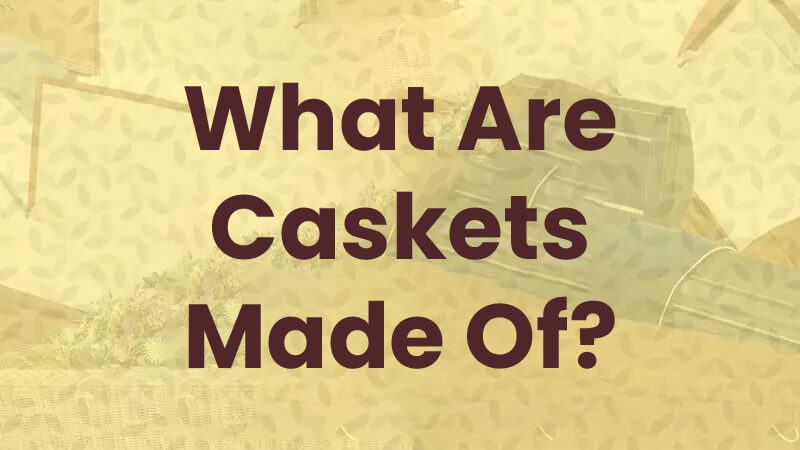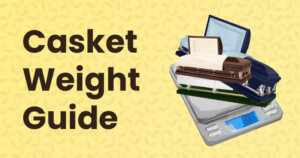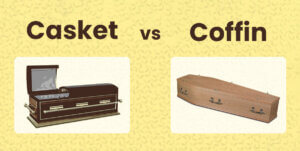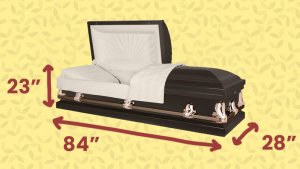While funeral rites and coffin materials have significantly transformed over the centuries, the underlying sentiments remain the same. We want to send our dead off comfortably and in style.
The most common materials coffins and caskets are made of are wood and metal. Most caskets are manufactured with 20-gauge steel, whereas coffins are typically made from pine, oak, or medium-density fiberboard. On the inside, you will usually find a soft-touch velvet or crepe lining.
However, these are just the most common materials. With new trends in the funeral industry popping up every day, there are now more options than ever.
Read on for a deep dive into the various casket and coffin materials and their pros and cons.
In This Article
The Difference Between Caskets and Coffins?
Before going any further, it’s worth distinguishing between caskets and coffins.
US readers will typically agree that any burial container should be called a “casket,” while those joining us from the UK refer to this final resting place as a “coffin.”
You usually won’t have to know anything beyond that.
However, if you have a particular style in mind, it’s good to know that these two terms can also be used to specify what kind of burial container you’re after.
Caskets

Caskets are typically made from steel or wood. They are rectangular boxes that usually have a hinged lid. Caskets can have a “full couch” – meaning a single lid – or a “half couch.” In this second case, half of the lid can open up to allow mourners to view just the top half of the deceased’s body to say goodbye.
Coffins

Coffins are almost exclusively made from wood like pine, mahogany, oak, or MDF.
A coffin is a hexagonal burial container that is wider in the shoulder area and tapers off where the feet will be placed. Because of their shape, coffins do not have hinged lids but ones that can be removed for viewing.
Hexagonal coffins are rarely used in the United States, but they are very popular in the United Kingdom and other countries like Ireland.
What Are the Most Common Casket Materials?
The modern funeral market gives you more diverse choices than ever before.
Not only are there many different types of casket materials, but there are also many different casket styles.
So, what are caskets made of?
Steel Caskets
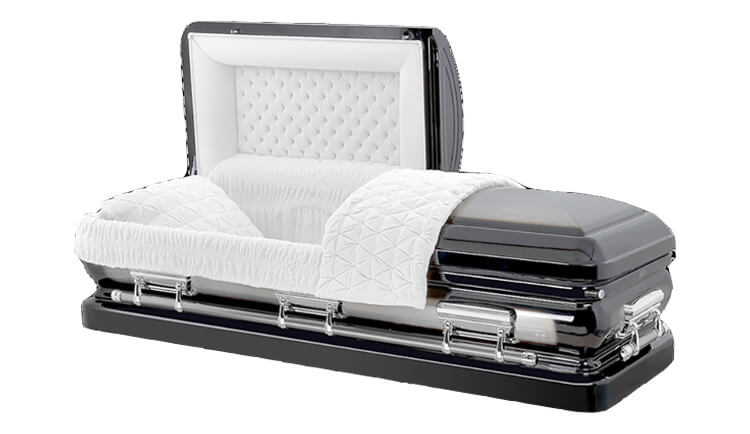
Steel is perhaps the most popular casket material – and there are, broadly speaking, two different options.
You can opt for a standard steel casket if you want an affordable option. These caskets are sturdy, durable, and offered in various sizes, styles, and gauges with an array of aesthetic finishes.
Stainless steel caskets are made from a combination of standard steel and chromium, making stainless steel an alloy. Caskets made from stainless steel are exceptionally durable. They, too, are manufactured in a wide variety of styles.
Steel caskets may have an added rubber seal, are lined with casket bedding, and usually cost between $1,000 and $5,000.
Related Article: 7 Best Caskets: Buyer’s Guide & How to Choose One [2023 Guide]
Precious Metal Caskets
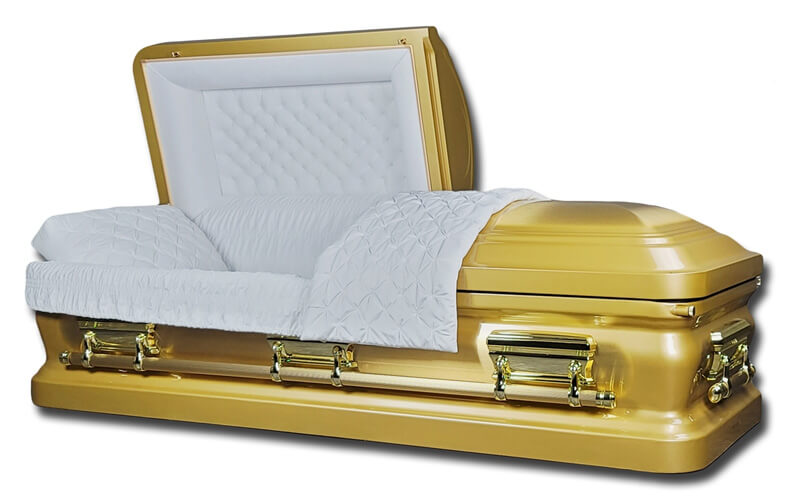
Opting for a casket made from gold, bronze, or copper is also possible.
These caskets offer the same benefits as steel caskets and can come with or without the same add-ons. On the other hand, the price tag is significantly higher — you’ll have trouble finding one for less than $5,000.
Gold, bronze, and copper caskets are designed for people who want (their loved ones) to be buried in style. You can achieve a similar effect with a steel casket with a metallic finish of your choice if you’d like to make some savings.
Hardwood Caskets

A wooden casket has an elegant, warm, and traditional appearance.
They break down a bit faster than metal caskets. They may be more suitable for people who like the idea of becoming one with the Earth again.
Not all woods are the same, however, and hardwood caskets are certainly the “premium” type of wood caskets.
The price of solid hardwood caskets depends on the casket’s thickness, the design (which may have elaborate carvings), and the type of wood. Budget will certainly be a consideration, but the choice of timber ultimately comes down to personal preference.
Walnut, mahogany, cherry, oak, and maple all count as hardwoods. Some readers will be surprised that birch and poplar, cheaper woods, are also considered hardwood when constructing caskets.
Softwood Coffins & Caskets
Softwoods like pine and willow are also popular for making wood caskets.
These woods are lighter and cheaper because they come from fast-growing trees. They also decompose at a faster rate.
Softwood coffins and caskets are extremely common in the United Kingdom.
Wood Veneer Caskets
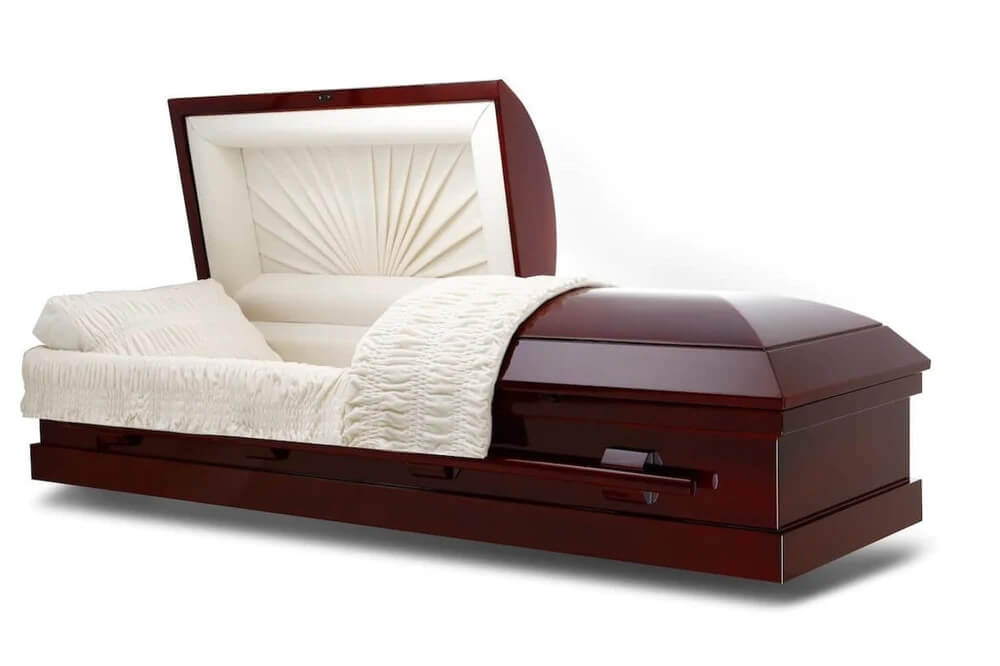
Wood veneer caskets look like hardwood caskets but are primarily made of MDF, fiberboard, or pressed wood.
Furniture makers already know that these materials often perform better than solid wood, and you can achieve the same look by adding a layer of wood veneer.
These caskets can save you thousands of dollars without affecting performance.
Laminate Caskets
A fiberboard casket with a laminate finish — that is, a layer of plastic designed to mimic the appearance of wood — is another option.
Laminate won’t be anyone’s first choice, and it certainly wouldn’t be mine, but these caskets are extremely affordable.
Fiberglass Caskets
Few know that modern caskets can also be made of fiberglass, an extremely durable and lightweight material.
You may have attended a funeral where a fiberglass casket was used without ever knowing. That’s because, once finishes are added to these caskets, they can be made to look like they’re made of wood, metal, or even marble.
Because fiberglass caskets can only hold bodies lighter in weight, they are most often used (sadly) for the funerals of infants and children.
Wicker Coffins
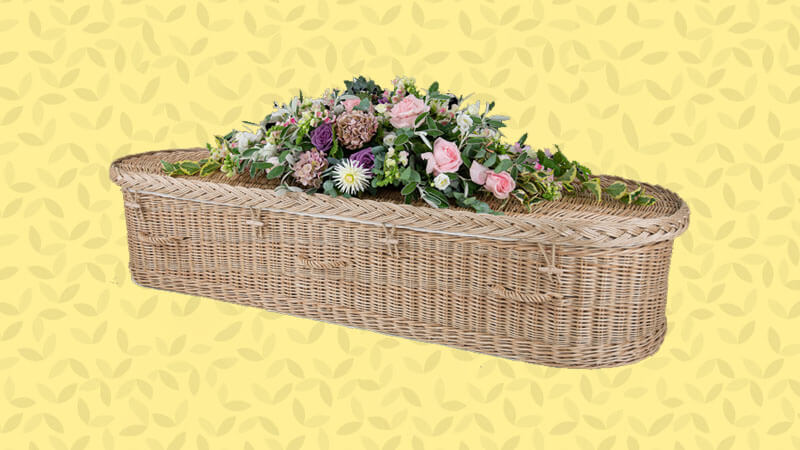
Wicker caskets or coffins are woven from biodegradable natural materials like rattan, sea grass, willow, reed, or bamboo.
Besides offering a beautiful natural look, these casket materials are also widely considered more ecologically conscious.
Wicker caskets or coffins are most suitable for people who would like to be buried in a more environmentally-sustainable way. Most are very simple, but some feature handles and hinges.
Related Article: Can You Be Buried Without a Casket? [Natural Burial Laws]
Wool Caskets
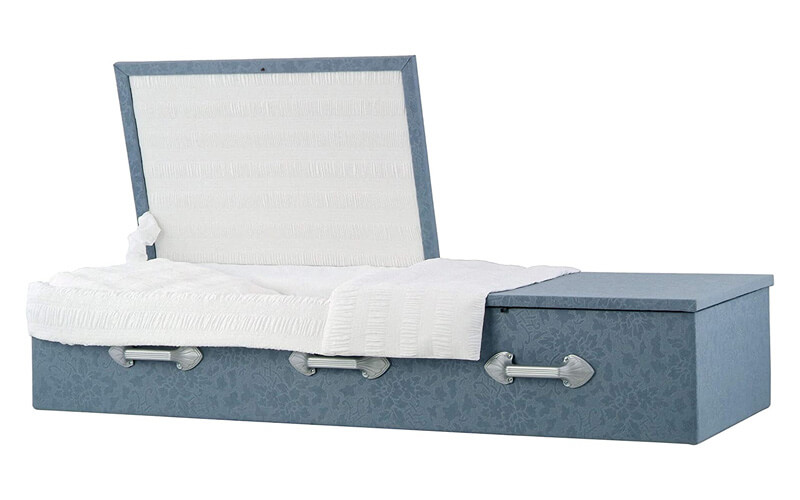
Caskets made from wool may be called wool, fleece, or cloth caskets or coffins. They are usually made with MDF on the inside, while the fabric wraps around the outside.
A relatively new innovation in the funeral industry, a wool casket is certainly an unorthodox choice.
This casket material may be the right choice for a loved one who enjoyed spinning or knitting, but it’s also reminiscent of a wish to wrap the deceased in a warm blanket.
Cardboard Caskets

You may have heard that deceased prisoners who don’t have anyone to pay for their funerals are placed in cardboard caskets (Note: Video Link).
This supremely affordable option is also used in cremations. In many cases, deceased people who will be cremated are placed in traditional rental caskets for the funeral service. Following this, they are transferred to a cardboard or another cheaper material casket, with which they will be cremated.
Some people may hate the idea of a “pompous” funeral — or dislike the thought of their loved ones spending a lot of money on an expensive casket. They may be able to opt for a cardboard casket in that case. The same is true for those desiring eco-friendly burials.
Fungus-Based Caskets

Loop’s “Living Cocoon” is too interesting not to mention.
This Dutch-invented coffin is made from mycelium, the fibrous networks that mushrooms and other fungi grow in beyond our line of sight.
The casket makes itself — mushrooms are given a mold in which they can grow in a particular shape.
Many modern funeral practices, such as the use of steel caskets, burial vaults, and casket liners, are designed to preserve bodies as long as possible.
The mycelium coffin does the opposite – it encourages faster and more natural decomposition.
Burial Shrouds
A burial shroud is a large cloth, usually made from biodegradable materials, used to wrap a body.
These shrouds can be made or bought and are growing in popularity as eco-friendly funerals are becoming more common.
They are also integral to several religious traditions, including Jewish and Islamic traditions.
Burial shrouds aren’t permitted in every cemetery. Hence, people who would like to be buried in one must research before they pass away.
Choosing the Right Casket Material For You
Choosing a casket is a deeply personal experience.
The process will depend on whether you’re choosing your own casket or selecting one for a loved one, but some of the considerations that enter into the process include the following:
Your budget. Whether we like it or not, the price of a casket is always a consideration.
The values of the deceased and those attending the funeral. Religious beliefs, personal beliefs about nature, or a wish to be modest or honored after death all play a role in casket selection.
Your sense of aesthetics. The good news is that you can get a casket that meets your personal expectations in any price range. If you turn to wood veneer or metal finish caskets, for example, you can achieve a more stylish or elaborate look for a fraction of the cost of a solid wood or metal casket. However, some people prefer simple fine caskets or even burial shrouds.
The cemetery’s requirements. Not all cemeteries permit all types of coffins. In many jurisdictions, a traditional cemetery is unlikely to allow a burial shroud or cardboard casket. In contrast, green cemeteries will not allow stainless steel or laminate caskets.
The Bottom Line
So, what are caskets made of? You now know all the options.
Besides casket materials, it’s good to note that caskets are often equipped with additional components. These may include bedding, hinges, a skirt that covers the hinges, a pillow, and handles.
Simpler caskets may not have all these components, and hexagonal coffins do not have hinged lids.
Choosing the right casket requires you to take all these factors into account. It’s not an easy choice, but with so many options on the market today, it’s only a matter of time before you find a casket that meets all your needs.
If you have any further questions about casket materials, coffins in general, or anything else beyond life, please feel free to leave a comment below or get in touch.

